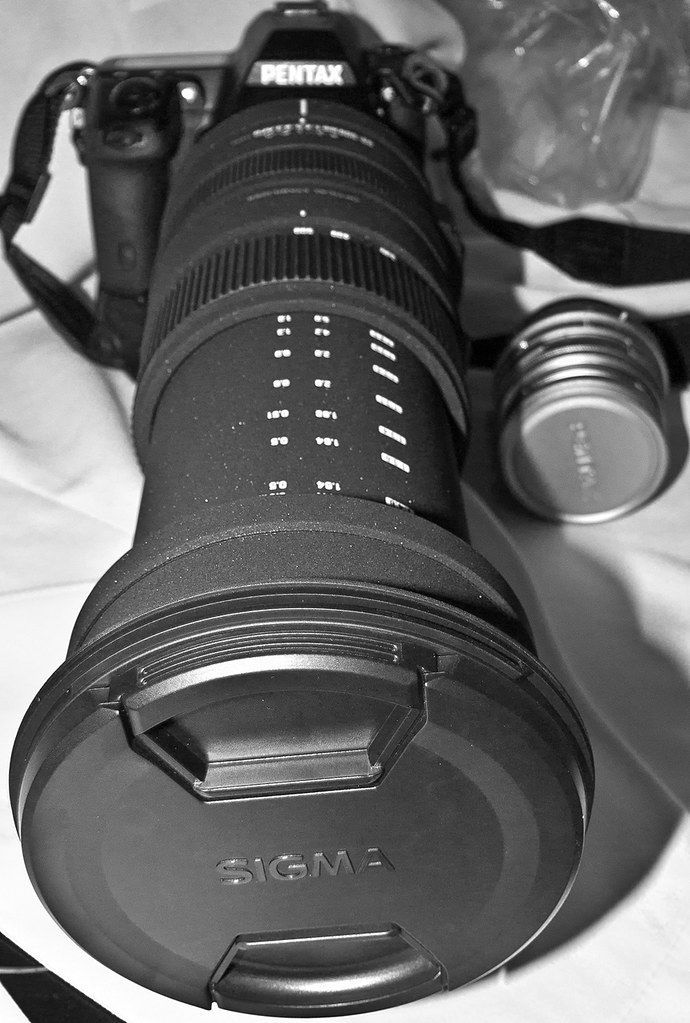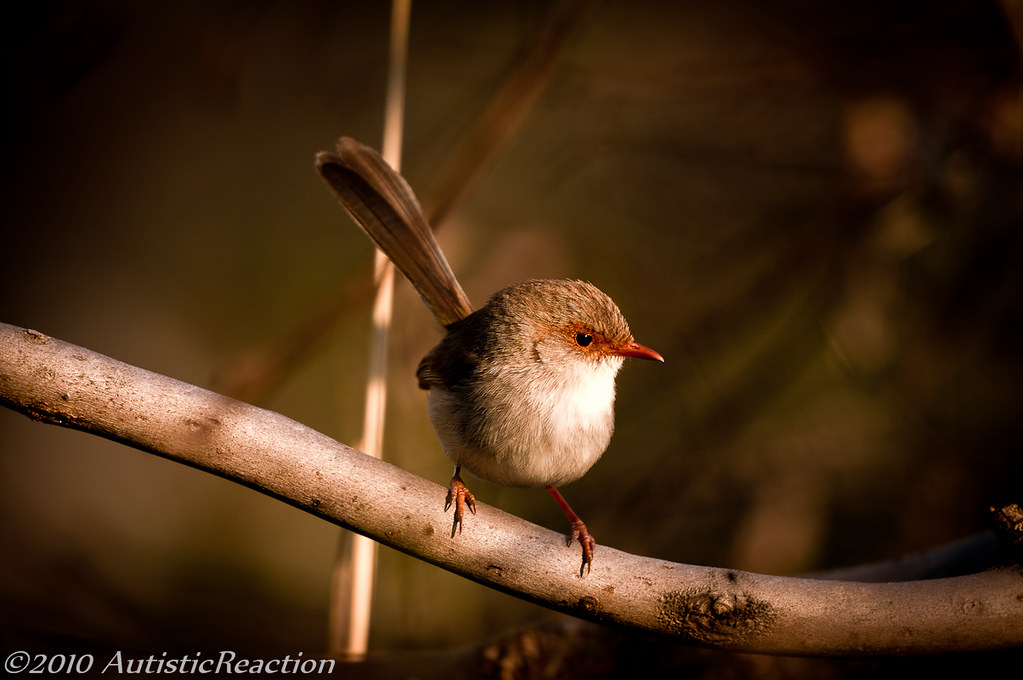
There are not a lot of choices for modern K mount zooms, Sigma offer a couple of options, in particular noteworthy are the newer 120-400mm and 150-500mm, both are considered a little less sharp than Bigma and are both slightly cheaper to purchase than my 50-500. They do also offer Sigma's latest HSM & OS technology, which i will look at in further detail later.
The first thing you notice about Sigma's large Telephoto zoom is the large box, and accessories that it ships with. The 50-500 has an APS-C lens hood, an FX lens hood, a step down ring (from 95 to 86mm) several straps, a large padded lens case, manuals, warranty card and both lens caps.

One of the great things about the lens hoods apart from it's size, is it's ability to attach the lens cap directly to the hood so the hood can be permanently attached when not shooting. I did however notice that unlike my other lens there was no red dot to align the lens itself to my K-7, with a little frustration i got it in and turned & clicked and now have it attached to the Pentax.
When handling Bigma for the first time you immediately notice the size/weight, as well as the build & quality of construction, it feels like a quality lens. The switches feel tight and responsive, the zoom and focus rings are very firm and require a good grip to turn them one handed. It's Big! Yes well that was to be expected now wasn't it? The size seems to reach about 12 inches with the APS-C hood and cap installed when not extended. (The image below does not have the lens hood on)

Switching the button from 'Lock' to 'Unlock' allows the lens to extend from it's 50mm stationary position to the extended position of your choice. The lens is marked with imperial and metric markers for distance and focal length, and has an awesome aperture marker which moves at the base of the lens inside a plastic window, the magnification is also listed at each focal length. The focal length EXIF info seems a little weird as it seems to only update at certain lengths.
This isn't the fastest lens ever obviously and with APS-C sensor cameras not the most well known for their high ISO / low noise performance especially on my Pentax K-7, the lens can indeed be a real challenge to use effectively in the field.
The aperture falloff is a little disappointing as at around 90mm the f/4.5 becomes a smaller f/5.6 and then around the 250-290mm mark the f/5.6 slows to the standard f/6.3 for the rest of focal length. Personally I would of liked the f/4.5 to last perhaps as far as 135 to 150mm, and F5.6 @ 300mm.

Bigma is a bit of a weird duck in focal length terms the shorter end is generally not needed by most who want a Wildlife or Birding lens, generally a 250-500mm would likely cover that area, but having the 50mm & wider end does allow for some versatility, the lens is also quite sharp at the wide end and stays quite decently sharp to about 240mm, with a progressive drop off from there that is quite acceptable from such a large zoom lens.
 If that's still not versatile enough for you Bigma allows for some decent macro shots too, with a max magnification of 1:3:1 @200mm Bigma allows some closeups via an impressive minimum focus distance for all focal lengths, it will surprise you how close you can get to your subjects with such a big lens in hand.
If that's still not versatile enough for you Bigma allows for some decent macro shots too, with a max magnification of 1:3:1 @200mm Bigma allows some closeups via an impressive minimum focus distance for all focal lengths, it will surprise you how close you can get to your subjects with such a big lens in hand.
Getting a decently sharp image in the 300-500mm range is going to take a decent shutter speed, in my own experience this can generally be achieved at about 1/250th of a second shutter speed on the K-7 when the Sigma lens OS is activated. At 250-300mm this is quite easily achieved on birds in trees and and other stationary objects, however the weight, overhang and extreme focal length make it a challenge beyond that at the 400-500mm mark. Sigma claim the OS is effective to around 4 stops, I would say it is one of the better OIS/SR systems around and it would almost reach that effective range.
The lens lacks a focus limiter, and i say it's a big thing to be missing on this lens, The built in HSM motor is quick and silent and often works well, but it does hunt a lot, trying to shoot into creeks, water, sky or tricky non contrasty areas will see Bigma confused at every opportunity and can be quite frustrating.
It's taken some technique to get Bigma to work effectively in the field, constantly balancing settings in regards to aperture, shutter & ISO in differing weather, and varied shooting conditions to make sure the shot is always allowed for. I myself settled on manual settings of 1/250th, F/8.0 and ISO 250 and with this setting i can shoot birds and the like when stationary in good light.

Shooting in Tav mode, which is Shutter & Aperture priority mode on the K-7, i can generally balance the shutter and aperture and let the camera choose the ISO, this helps in those situations where speed is required, dialing in a little EV compensation helps too. Being efficient at handling Bigma requires constant adjustments, so going from cloud to sky or bird to flying bird, is usually handled more proficiently by TaV than in Manual mode. (Pentax's green button can be of great use too....)
I find that I'm using a hybrid manual focus system to shoot Dragonflies in flight, often using the AF button to lock onto a surrounding area, and then using the MF ring to adjust it back to actually see the dragonflies. (not fun @ 500mm) This takes a lot of coordination and effort to do quickly enough to get the shot of them using the left hand for stabilization, focus and also zoom, using 1/5000th shutter as they zigzag across the top of the pond at high speeds, often never pausing for more than a moment.
An hour of following Zigzagging insects across a reflective pond, one eyed & holding the lens extended from 300 to 500mm while fighting camera settings in addition to using both autofocus and manual focus together in time to snap the shot is a tough workout and will take it's toll physically, especially on the wrists and patience of any man. :)
This is the result @ 1/4000th & ISO 1600:

After several weeks in the field, the lens is starting to fade a little in areas of paint, and their is a fair amount of dust behind the frontal element, which i consider a design flaw of Bigma, as this is well reported on both older and newer models and is quite disappointing, perhaps a future model with circular aperture blades and WR build are in order, it would make me feel better with all this pollen around.
The other technicalities are all decent, distortion is controlled well (especially by the ACR profiles) and the amount of CA or purple fringe is very well controlled, i experience almost none even when shooting directly into the sun. The filter thread is 95mm or 86mm with the step down ring and this allows the ability to use standard filters such as UV, ND and CPL, although there is a warning with the CPL & step-down ring together. The large diameter means there is few cheap filters available (none from DX in 95 or 86mm) so costing a Hoya CPL or other expensive UV means prices of $150-350 is standard.

Bigma comes standard with a tripod collar attached to the lens, I personally rotated the collar 45 degrees, which made a big difference in my hand holding of the lens, and allowed a large surface area to be held which means less stress on my hands/wrists. In regards to tripod use I have found my tripod to not handle the weight on shots of the Moon for example, where Bigma is angled above 20-40degrees there is a certain amount of drooping and creeping when trying to hold those angles on my tripod mounts, so i recommend a very decent Tripod, Monopod & matching head.

I was told to expect to want a Monopod, So I was going to add a carbon fiber monopod and applicable head, but have since realized that the hand holding is not as bad as I had feared, in fact I'm quite surprised and impressed at how easy to hand hold bigma in the field is, and how comfortable to use at the same time. So far I've likely taken around 2500 shots with Bigma, and have indeed enjoyed my time with her, the wildlife, birds & insects are far less trusting however with the bigger lens attached.

So those are my experiences with Bigma thus far, I am glad I purchased the lens, and i hope to get some good use out of it over the next 2 years, the above images were all taken over a 2 week period around my local neighborhood. I will make changes, additions and more thoughts over the next few months.